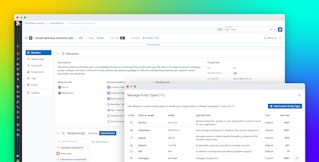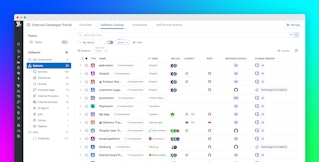
Lei Wang

David Lentz
The Datadog Software Catalog centralizes your organization’s knowledge about the ownership, reliability, performance, costs, and security of your services. If you’re also using Backstage to keep track of your services, you can leverage our support for Backstage YAML to easily consolidate and maintain all your service information in the Software Catalog.
By automatically importing your Backstage YAML, Datadog lets you manage all your services in a single platform, so you can view service data side-by-side with observability data from your applications and infrastructure and eliminate knowledge gaps. Datadog also keeps your Software Catalog complete and up to date, even as you create and modify services in Backstage.
In this post, we’ll show you how to:
- Populate the Software Catalog with your Backstage YAML
- Import multiple service definitions to easily create or modify any number of services
- Validate service metadata by viewing schema version information
Populate the Software Catalog with your Backstage YAML
The Software Catalog gives teams throughout your organization a central repository for managing services. When you enable the GitHub integration—as shown in the screenshot below—Datadog will automatically create and maintain Software Catalog entries for your Backstage services.
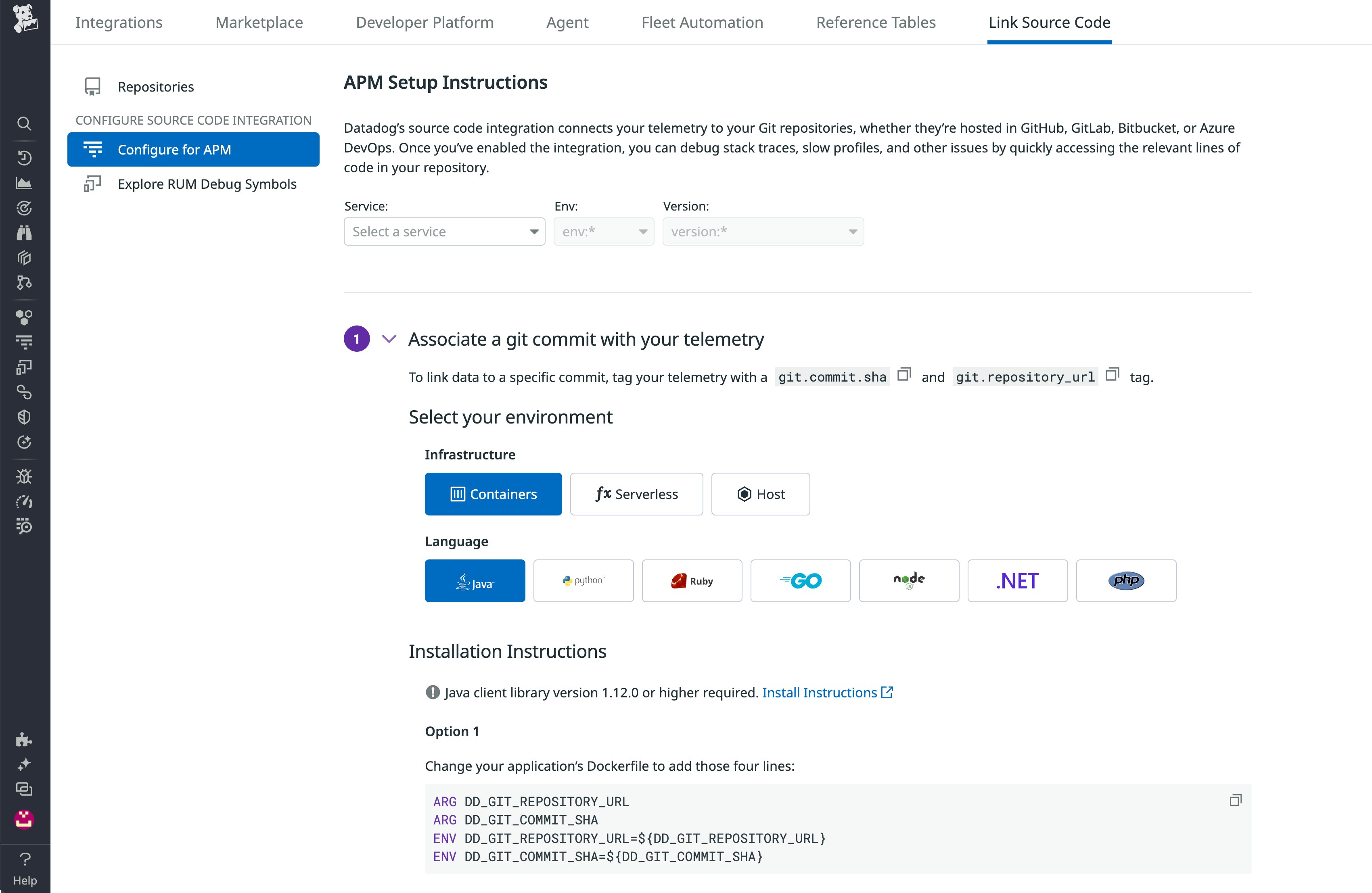
The integration constantly scans your repositories for Backstage YAML files named service.datadog.yaml and catalog-info.yaml—which you create when you add your service to the Backstage Software Catalog. The code snippet below shows an example of catalog-info.yaml.
apiVersion: backstage.io/v1alpha1kind: componentmetadata: annotations: backstage.io/techdocs-ref: github://design/doc some.annotation: value namespace: distribution name: delivery-tracker title: Delivery App description: delivery app component responsible for transit processes tags: ["framework:spring", "db:mysql"] links: - title: Wiki url: https://backstage.core.shopist.org/docs/default/component/delivery-cancel icon: help - title: runbook url: https://backstage.core.shopist.org/docs/default/component/rollback icon: help - title: source url: https://gitlab.shopist.org/shopist/delivery-app icon: gitlab - title: jira url: https://shopist.atlassian.net/browse/DA icon: help - title: diagram url: https://shopist.atlassian.net/wiki/spaces/DA icon: help ignore-attribute: id: 1 value: "ignore_value"spec: type: service lifecycle: production owner: delivery-app system: logisticsDatadog automatically imports these new or revised Backstage files to keep the Software Catalog up to date. Along with the ability to automatically create and maintain Software Catalog entries based on your Datadog-formatted service definition files, this enables you to troubleshoot, investigate, and collaborate across all your services in a single platform.
As an alternative to using the GitHub integration, you can post Backstage YAML files to the Datadog API. This allows you to programmatically send Backstage service definitions that may not exist in your GitHub repositories.
Import multiple Backstage service definitions at once
To quickly get started managing all your Backstage services in the Software Catalog, you can register any number of new services by adding their definitions to a single YAML file and then sending that file to Datadog via the API or adding it to a repository to be imported by our GitHub integration. The code snippet below shows an example of how you could define multiple services in a single YAML file. Each service definition begins with three dashes to delineate it from the other services.
---apiVersion: backstage.io/v1alpha1kind: componentmetadata: annotations: backstage.io/techdocs-ref: github://architecture/doc namespace: shopping name: delivery-transit-prod title: Delivery App Transit description: delivery-app component responsible for transitspec: type: service lifecycle: production owner: delivery-app system: logistics
---apiVersion: backstage.io/v1alpha1kind: componentmetadata: annotations: backstage.io/techdocs-ref: github://architecture/doc namespace: shopping name: delivery-aggregate-prod title: Delivery App Aggregation description: delivery-app component responsible for aggregation spec: type: service lifecycle: production owner: delivery-app system: logisticsAfter you’ve imported your Backstage YAML, all your service data will be centralized in Datadog, alongside observability and security data from your applications and infrastructure.
Ensure valid metadata by viewing schema and version information
Datadog creates and maintains Software Catalog entries from the Backstage YAML you provide. That YAML is based on the Backstage schema, which includes the metadata required by the Backstage Software Catalog. But that schema leaves out some metadata that the Software Catalog can use to help your team manage the complexity of your microservices architecture.
Software Catalog makes it easy to see which service definitions are based on the Backstage schema so that you can easily identify services that might be missing key metadata.
In the screenshot below, the Schema Version column is highlighted to show the schema used by each service definition. Datadog has imported Backstage YAML for services such as bitsburg to automatically create Software Catalog entries for them. You can see that this service is based on the Backstage schema, which indicates an opportunity to enrich it with additional metadata that the Software Catalog can use, such as a service team’s on-call schedule and contact information.
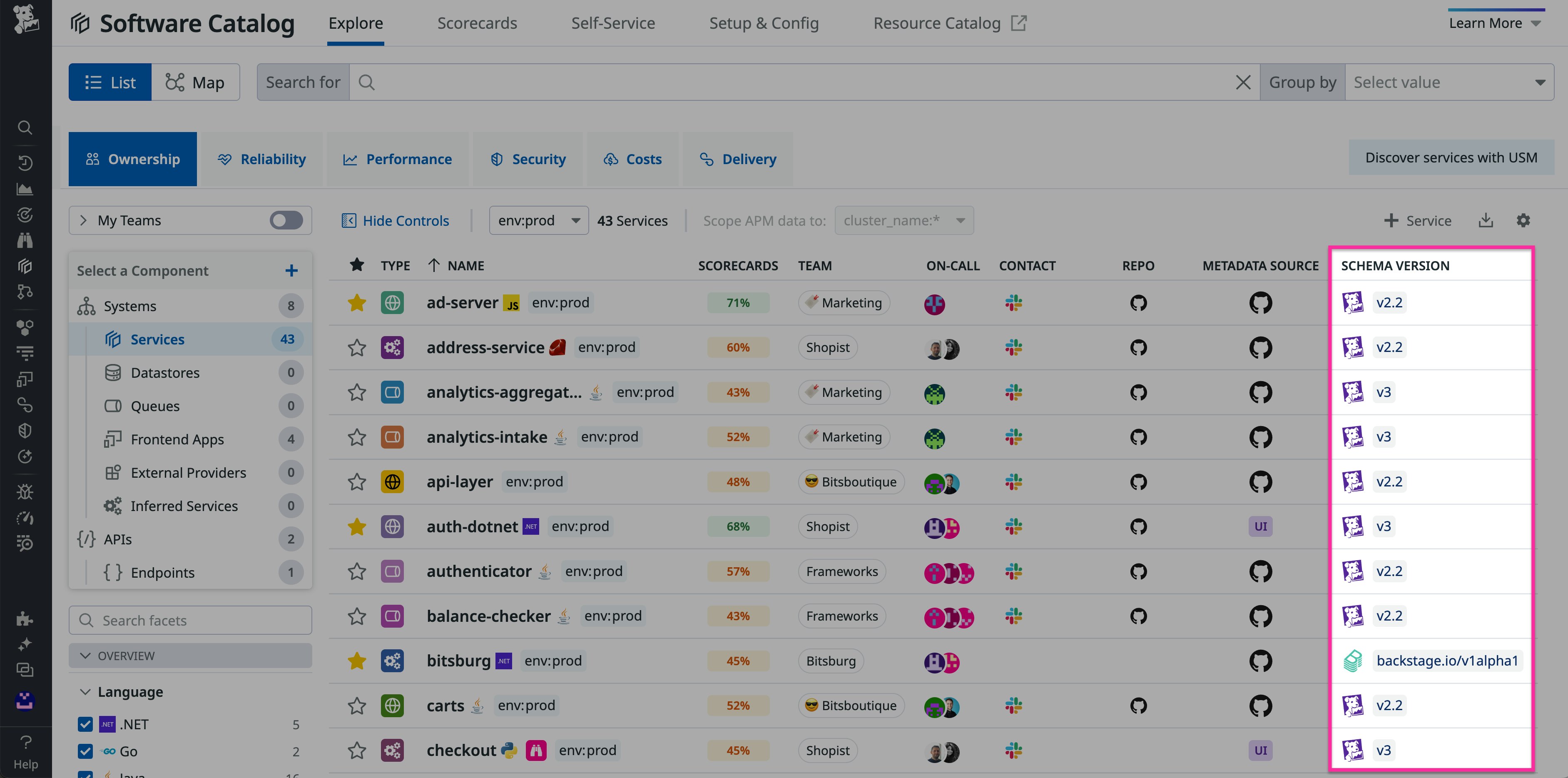
Once a Backstage service definition has been imported, you can update it to ensure that the service metadata is complete and that it takes full advantage of the Software Catalog’s capabilities to help you organize and communicate information about your services. The screenshot below shows the built-in editor where you can add or modify service metadata. We’ve added a URL to the PagerDuty integration field so that the Software Catalog will show on-call information for this service.
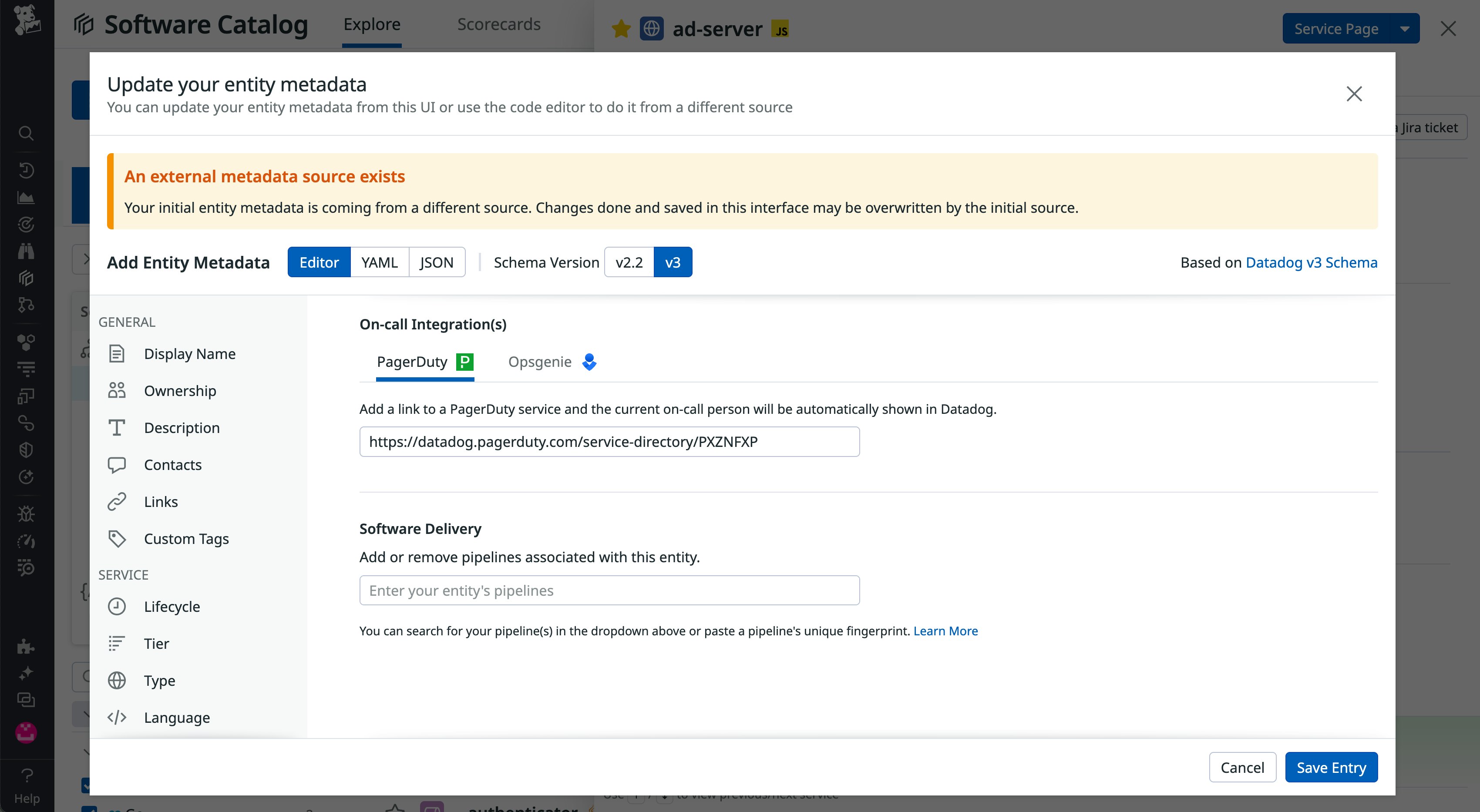
Once you’ve modified metadata that’s been imported from Backstage, it’s automatically converted to use the Datadog schema. In the screenshot below, the Software Catalog shows that the service now uses version 2.2 of the Datadog schema. The on-call column now shows contact information for the team members currently on call.
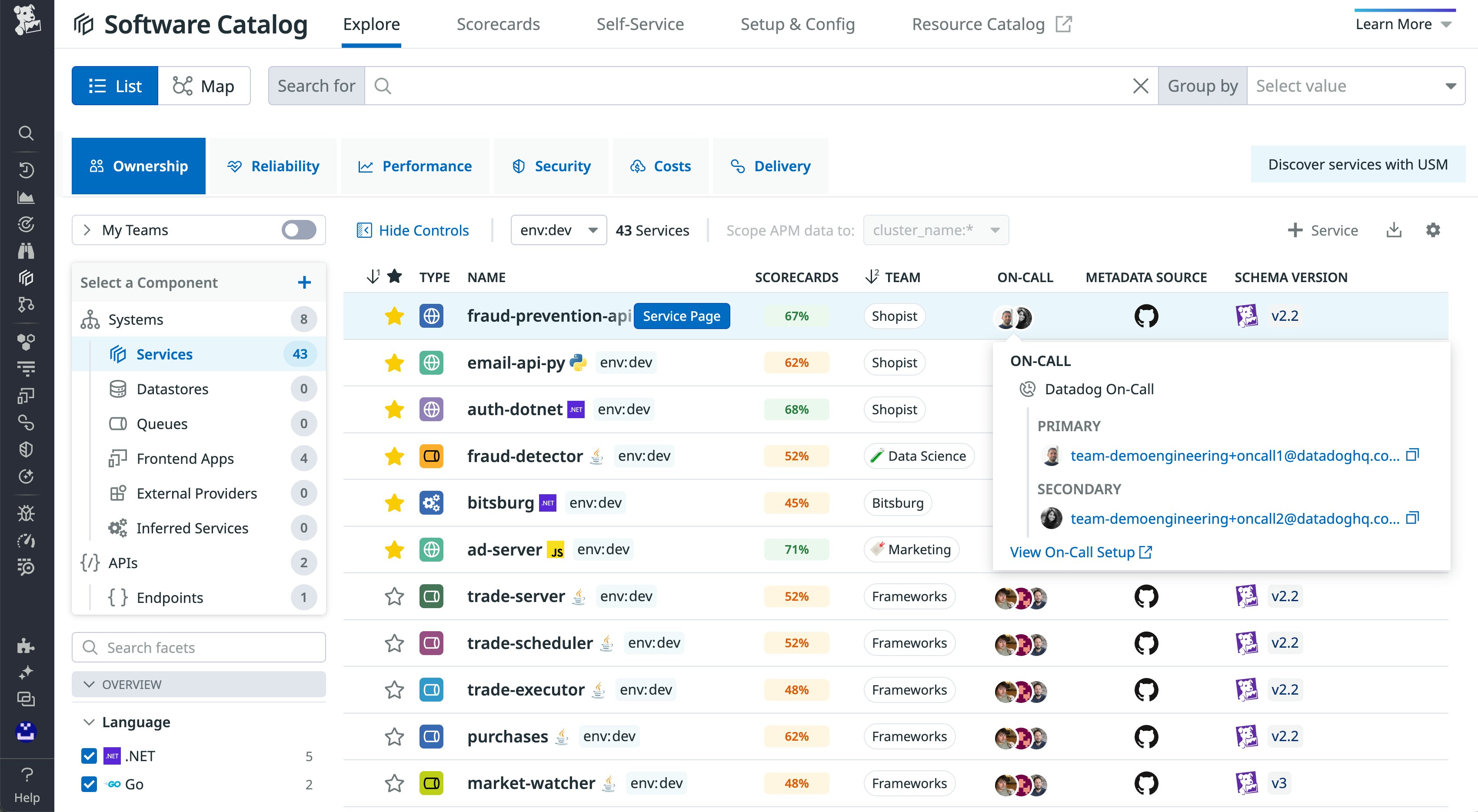
Manage all your services with the Software Catalog
With support for Backstage YAML, Datadog automatically creates and maintains Software Catalog entries for your Backstage-based services so that you have a single platform that provides visibility into all your services. See our documentation to start importing Backstage service definitions into the Software Catalog.
You can also populate the Software Catalog using APM, USM, service telemetry, and via the Datadog UI. If you’re not already using Datadog, you can start today with a 14-day free trial.




